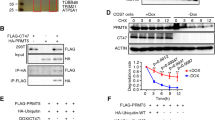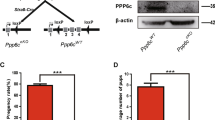Abstract
A novel spermatogenesis associated factor (SPAF) was found to be aberrantly expressed at the malignant conversion stage in a clonal epidermal model of chemical carcinogenesis. Sequence analysis revealed two ATPase modules, classifying this gene as a new member of the AAA-protein family (ATPase associated with diverse activities). Immunohistochemical staining of mouse testis sections with SPAF antibody localized expression to spermatogonia and early spermatocytes in the basal compartment of the seminiferous tubules. Northern and Western analysis of SPAF expression in testes of mice at different developmental stages confirmed its expression at early stages of spermatogenesis. In view of a mitochondrial-localization-like signal, sequence similarities to membrane-associated proteins, ATP binding properties, and intracellular expression patterns in testis, we speculate that SPAF protein may be involved in morphological and functional mitochondrial transformations during spermatogenesis. Ectopic expression of the SPAF gene in malignant epidermal cells may signify adoption of an early germ cell-like phenotype advantageous in malignant conversion.
This is a preview of subscription content, access via your institution
Access options
Subscribe to this journal
Receive 50 print issues and online access
$259.00 per year
only $5.18 per issue
Buy this article
- Purchase on Springer Link
- Instant access to full article PDF
Prices may be subject to local taxes which are calculated during checkout








Similar content being viewed by others
References
Acharya U, Jacobs R, Peters JM, Watson N, Farquhar MG and Malhotra V . 1995 Cell 82: 895–904
Babst M, Sato TK, Banta LM and Emr SD . 1997 EMBO J 16: 1820–1831
Balmain A, Krumlauf R, Vass JK and Birnie GD . 1982 Nucleic Acids Res 10: 4259–4277
Bellve AR, Cavicchia JC, Millette CF, O'Brien DA, Bhatnagar YM and Dym M . 1977 J Cell Biol 74: 68–85
Beyer A . 1997 Protein Science 6: 2043–2058
Braun RE, Peschon JJ, Behringer RR, Brinster RL and Palmiter RD . 1989 Genes Dev 3: 793–802
Clark-Maguire S and Mains PE . 1994 Genetics 136: 533–546
Confalonieri F and Duguet M . 1995 Bioessays 17: 639–650
Confalonieri F, Marsault J and Duguet M . 1994 J Mol Biol 235: 396–401
De Martino C, Floridi A, Marcante ML, Malorni W, Scorza Barcellona P, Bellocci M and Silvestrini B . 1979 Cell Tissue Res 196: 1–22
Eakle KA, Bernstein M and Emr SD . 1988 Mol Cell Biol 8: 4098–4109
Egerton M, Ashe OR, Chen D, Druker BJ, Burgess WH and Samelson LE . 1992 EMBO J 11: 3533–3540
Erdmann R, Wiebel FF, Flessau A, Rytka J, Beyer A, Frohlich KU and Kunau WH . 1991 Cell 64: 499–510
Feiler HS, Desprez T, Santoni V, Kronenberger J, Caboche M and Traas J . 1995 EMBO J 14: 5626–5637
Frohlich KU, Fries HW, Rudiger M, Erdmann R, Botstein D and Mecke D . 1991 J Cell Biol 114: 443–453
Fukasawa K and Vande Woude GF . 1995 Proc Natl Acad Sci USA 92: 3430–3434
Hackenbrock CR, Rehn TG, Weinbach EC and Lemasters JJ . 1971 J Cell Biol 51: 123–137
Han KA and Kulesz-Martin MF . 1992 Cancer Res 52: 749–753
Han KA, Rothberg P and Kulesz-Martin M . 1990 Mol Carcinogenesis 3: 75–82
Hartl FU, Pfanner N, Nicholson DW and Neupert W . 1989 Biochim Biophis Acta 988: 1–45
Hruban Z, Kirsten WH and Slesers A . 1966 Lab Invest 15: 576–588
Hruban Z, Mochizuki Y, Morris HP and Slesers A . 1973 J Natl Cancer Inst 50: 1487–1495
Kemp CJ, Donehower LA, Bradley A and Balmain A . 1993 Cell 74: 813–822
Kozak M . 1991 J Cell Biol 115: 887–903
Kulesz-Martin MF, Penetrante R and East CJ . 1988 Carcinogenesis 9: 171–174
Kunau WH, Beyer A, Franken T, Gotte K, Marzioch M, Saidowsky J, Skaletz-Rorowski A and Wiebel FF . 1993 Biochimie 75: 209–224
Latterich M, Frohlich KU and Schekman R . 1995 Cell 82: 885–893
Liu Y and Kulesz-Martin MF . 1998 Carcinogenesis 19: 683–686
Mian I . 1993 Trends Biochem Sci 18: 125–127
Nelbock P, Dillon PJ, Perkins A and Rosen CA . 1990 Science 248: 1650–1653
Nigg EA . 1991 Semin Cell Biol 2: 261–270
Rabouille C, Levine TP, Peters JM and Warren G . 1995 Cell 82: 905–914
Sambrook J, Fritsch EF and Maniatis T . 1989 Molecular Cloning a laboratory manual Cold Spring Harbor Laboratory Press Cold Spring Harbor, New York
Schneider BL, Bowden GT, Sutter C, Schweizer J, Han KA, Kulesz-Martin and MF . 1993 J Invest Derm 101: 595–599
Schwartz D, Goldfinger N and Rotter V . 1993 Oncogene 8: 1487–1494
Shaw G and Kamen R . 1986 Cell 46: 659–667
Sjoblom T and Lahdetie J . 1996 Oncogene 12: 2499–2505
Troutt AB, McHeyzer-Williams MG, Pulendran B and Nossal GJ . 1992 Proc Natl Acad Sci USA 89: 9823–9825
Waites GM and Gladwell RT . 1982 Physiol Rev 62: 624–671
Walker JE, Saraste M, Runswick MJ and Gay NJ . 1982 EMBO J 1: 945–951
White MT, Arya DV and Tewari KK . 1974 J Natl Cancer Inst 53: 553–559
Wilson DW, Wilcox CA, Flynn GC, Chen E, Kuang WJ, Henzel WJ, Block MR, Ullrich A and Rothman JE . 1989 Nature 339: 355–359
Wolfes H, Kogawa K, Millette CF and Cooper GM . 1989 Science 245: 740–743
Zabludoff SD, Wright WW, Harshman K and Wold BJ . 1996 Oncogene 13: 649–653
Acknowledgements
We thank Dr C Wenner, Dr AJ Kinniburgh, and Dr GT Bowden for critical comments. We also thank Dr P Welch for discussion and assistance in immunohistochemical analysis; Mr Joseph Brachman for immunization of rabbits; the RPCI DNA polymer facility for DNA sequencing and oligonucleotide synthesis; M Vaughan for histological assistance; and D Ogden, S Dave; and E Howley for the electron microscopy. This study was supported by NIH RO1 CA31101 and RPCI Institute Core CA16056.
Author information
Authors and Affiliations
Rights and permissions
About this article
Cite this article
Liu, Y., Black, J., Kisiel, N. et al. SPAF, a new AAA-protein specific to early spermatogenesis and malignant conversion. Oncogene 19, 1579–1588 (2000). https://doi.org/10.1038/sj.onc.1203442
Received:
Revised:
Accepted:
Published:
Issue Date:
DOI: https://doi.org/10.1038/sj.onc.1203442
Keywords
This article is cited by
-
Hominoid SVA-lncRNA AK057321 targets human-specific SVA retrotransposons in SCN8A and CDK5RAP2 to initiate neuronal maturation
Communications Biology (2023)
-
Transcriptome analysis reveals differentially expressed genes between the ovary and testis of the honey bee Apis mellifera
Apidologie (2022)
-
4q27 deletion and 7q36.1 microduplication in a patient with multiple malformations and hearing loss: a case report
BMC Medical Genomics (2020)
-
Identification and population genetic analyses of copy number variations in six domestic goat breeds and Bezoar ibexes using next-generation sequencing
BMC Genomics (2020)
-
DNA methylation signatures of educational attainment
npj Science of Learning (2018)



